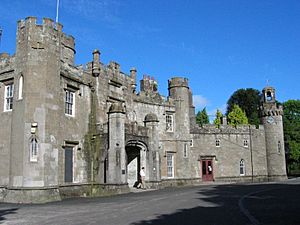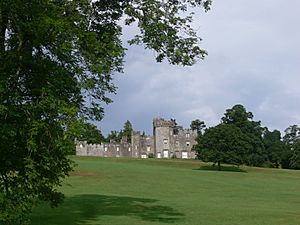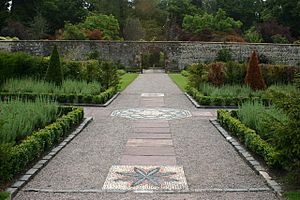Balloch Castle facts for kids
Quick facts for kids Balloch Castle |
|
|---|---|

Entrance front of Balloch Castle
|
|
|
Listed Building – Category A
|
|
| Designated | 14 May 1971 |
| Reference no. | LB123 |
|
Inventory of Gardens and Designed Landscapes in Scotland
|
|
| Designated | 1 July 1987 |
| Reference no. | GDL00042 |
| Lua error in Module:Location_map at line 420: attempt to index field 'wikibase' (a nil value). | |
Balloch Castle is a beautiful country house built in the early 1800s. You can find it at the very southern end of Loch Lomond in West Dunbartonshire, Scotland. For hundreds of years, starting in the 11th century, the land of Balloch belonged to the Lennox family. They built an older castle here in the 1200s.
Later, in the 1800s, a man named John Buchanan bought the land. He decided to knock down the old castle ruins and build the house we see today. This new castle has a special style called Tudor Gothic. It was designed by an architect named Robert Lugar. In 1915, the city of Glasgow bought Balloch. Since 1975, the local council has looked after it. The castle grounds became a country park in 1980. Since 2002, it has also been part of the amazing Loch Lomond and The Trossachs National Park.
Even though the house has been used for visitors and offices, it now needs some repairs. It is on a list of "Buildings at Risk." Balloch Castle is a very important historic building, known as a category A listed building. Its gardens are also special, listed on the Inventory of Gardens and Designed Landscapes in Scotland.
Contents
History of Balloch Castle
The First Castle
The land where Balloch Castle stands was given to the Lennox family way back in 1072. This gift came from King Malcolm III of Scotland. It was part of their large area called the Earldom of Lennox. The Lennox earls built the first Balloch Castle around 1238. They lived there until about 1390. Many important papers from that time were signed at Balloch.
After a while, the earls moved their main home to Inchmurrin island in Loch Lomond. You can still see parts of their castle there from the late 1300s. The first Balloch Castle was closer to the water than the one today. There are no walls left, but you can still see the shape of the old castle in the ground. It looks like a bumpy mound, about 50 by 45 meters, with a ditch around it. This old site is protected as a scheduled monument.
In the 1400s, Balloch and the Lennox lands went to the Stewart family. It stayed with them until 1652. Then, the 4th Duke of Lennox sold it to John Colquhoun of Luss.
The Castle We See Today
The current Balloch Castle was built as a home between 1808 and 1809. John Buchanan of Ardoch ordered it to be built. He was a rich merchant from Glasgow. Buchanan bought the Balloch estate in 1800. He was involved in his father's hat-making business. He was also a partner in the Ship Bank, which was Glasgow's oldest bank. John Buchanan even represented the area of Dunbartonshire in the Scottish parliament from 1821 to 1826.
The castle's architect was Robert Lugar, who worked in London. He had also designed another nearby castle. Balloch Castle is built in a style called Tudor Gothic. This means it looks like old castles but was built much later. The towers and crenellations (the battlements on top) are just for decoration. They were not for defense. The tall, narrow lancet windows and other details copy older castle styles. Lugar helped bring this "picturesque" castle style to Scotland. It's possible that some stones from the old castle were used in the new building. Buchanan also created the beautiful park around the castle. He planted many special trees and plants.
Recent History
In 1830, John Buchanan bought another estate nearby called Boturich. He asked Robert Lugar to rebuild that castle too. Buchanan then moved there and sold Balloch Castle. Over the 1800s, Balloch had several different owners. One owner, Mr Gibson Stott, made even more improvements to the parks.
In 1915, the City of Glasgow bought the estate. It was a huge area, about 815 acres. They bought it so that everyone could visit and enjoy the open space. Glasgow City Council still owns the park and house today. However, since 1975, West Dunbartonshire Council has looked after them. The park officially became a country park in 1980. The house has been a very important category A listed building since 1971.
The castle building has been used for different things over the years. It has had visitor centers and offices inside. But by 2008, the building was not in good shape. It was added to the Buildings at Risk Register for Scotland. In 2014, plans were made to fix the building. West Dunbartonshire Council announced they would repair it to keep it safe.
Balloch Castle Estate
The castle grounds are like a big, beautiful park. They have two main "pleasure gardens." One is north of the house. It has many rhododendrons and azaleas. These flowers are most colorful in late May and early June. To the south, there is a walled garden. It is full of flowers and shrubs.
Between these two gardens, there is a large grassy area that goes down to the loch. This area has special trees planted in it. The whole park is surrounded by lovely woodlands. In 2001, a big project costing £2.3 million helped to make the castle grounds even better. They opened up old views and managed the woodlands. Money for this came from the Heritage Lottery Fund, Scottish Enterprise, and the council.




